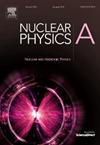Estimating centrality in heavy-ion collisions using Transfer Learning technique
IF 1.7
4区 物理与天体物理
Q2 PHYSICS, NUCLEAR
引用次数: 0
Abstract
In this study, we explore the applicability of Transfer Learning techniques for estimating collision centrality in terms of the number of participants () in high-energy heavy-ion collisions. In the present work, we leverage popular pre-trained CNN models such as VGG16, ResNet50, and DenseNet121 to determine in Au+Au collisions at GeV on an event-by-event basis. Remarkably, all three models achieved good performance despite the pre-trained models being trained for databases of other domains. Particularly noteworthy is the superior performance of the VGG16 model, showcasing the potential of transfer learning techniques for extracting diverse observables from heavy-ion collision data.
利用迁移学习技术估计重离子碰撞中的中心性
在这项研究中,我们探索了迁移学习技术在高能重离子碰撞中根据参与者数量(Npart)估计碰撞中心性的适用性。在目前的工作中,我们利用流行的预训练CNN模型,如VGG16, ResNet50和DenseNet121,以每个事件为基础确定sNN=200 GeV下Au+Au碰撞中的Npart。值得注意的是,尽管预训练模型是针对其他领域的数据库进行训练的,但这三种模型都取得了良好的性能。特别值得注意的是VGG16模型的卓越性能,展示了迁移学习技术在从重离子碰撞数据中提取不同观测值方面的潜力。
本文章由计算机程序翻译,如有差异,请以英文原文为准。
求助全文
约1分钟内获得全文
求助全文
来源期刊

Nuclear Physics A
物理-物理:核物理
CiteScore
3.60
自引率
7.10%
发文量
113
审稿时长
61 days
期刊介绍:
Nuclear Physics A focuses on the domain of nuclear and hadronic physics and includes the following subsections: Nuclear Structure and Dynamics; Intermediate and High Energy Heavy Ion Physics; Hadronic Physics; Electromagnetic and Weak Interactions; Nuclear Astrophysics. The emphasis is on original research papers. A number of carefully selected and reviewed conference proceedings are published as an integral part of the journal.
 求助内容:
求助内容: 应助结果提醒方式:
应助结果提醒方式:


